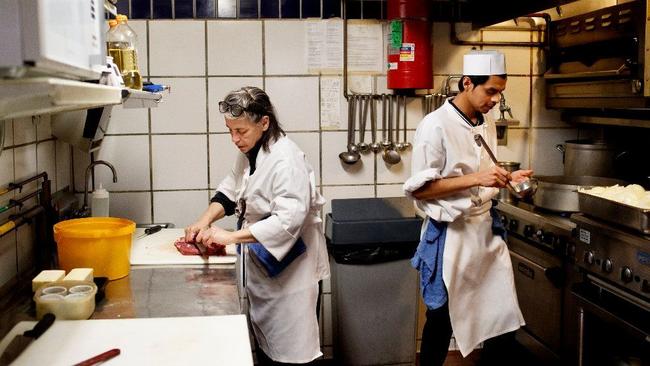
Feb 1, 2019
Ashok Selvam | Eater Chicago | January 31, 2019
SVN Restaurant Resource Group’s Marcus Sullivan, Tim Rasmussen, and Shane Sackett represented the landlord in the transaction.
The group behind Giant, one of Chicago’s essential restaurants, is planning to open a bar that will serve Chinese-American food in Bucktown. The project’s called Chef’s Special Cocktail Bar and its inspiration comes from the Chinese restaurants chef Jason Vincent ate at growing up in Cleveland. It’s slated to open this summer at 2165 N. Western Avenue, the former Siboney Cuban Cuisine.
Restaurant partner Josh Perlman makes no secret that no one on staff is of Chinese heritage, and they aren’t trying to define the cuisine. Perlman, Vincent, and another partner — Ben Lustbader — are all Jewish. The trio shares memories of eating Chinese food on Christmas like many American Jews do. Chef’s Special will feature items like Mongolian beef, egg foo young, fried rice, and noodles. The menu is an homage to the owners’ nostalgia, not a pledge to authenticity. The name also shows a flexibility. “Chef’s special” may remind some of other Chinese restaurants, but it’s also supposed to represent an inventive kitchen philosophy. Perlman said ownership is cognizant of being respectful of the culture.
“We don’t want to come across that we’re an authority on what these dishes have to be, or what they have to have in them,” he said.
The menu will also have rotating specials with more “experimental” items. They’re still developing the menu, but Perlman suggested Chinese-inspired pizzas, burgers and even lasagna. These are just ideas as Perlman hasn’t consulted with the kitchen staff. When he does, he may ask them if Chef’s Special will offer a sequel to Giant’s popular uni shooter.
They’re still experimenting with the space’s configuration, but expect a dining room with room for 75 and a bar with seating for 12. They’ll also have outdoor seating on Palmer Avenue. The drink program, handled by Perlman and GM Chase Bracamontes (Publican, Giant) will feature natural wines, local beers, and cocktails. The drinks will feature Asian ingredients. Perlman said they’re working on a lychee/vanilla drink. They’re not doing tiki. Perlman wants to go beyond the usual Rieslings and offer other wines that pair well with spicy foods. The restaurant may also offer a bar menu. It will stay open late seven days a week and also offer take out. Ownership thinks carry outs are mandatory for a Chinese restaurant.
CONTINUE READING

Jan 25, 2019
Dana Vollmer | NPR Illinois | January 23, 2019
The Illinois Supreme Court is considering whether Chicago’s regulations on food trucks unfairly stifle competition.
A city ordinance bans food trucks from parking within 200 feet of the entrance to a brick-and-mortar restaurant. The city claims it protects property taxpayers who invest in their storefronts.
Attorney Robert Frommer, who represents food truck owners, said the court’s decision could have implications beyond the dining sector.
“No matter the industry, officials could hobble newcomers to protect entrenched existing groups who they claimed were important, too,” Frommer told the court. “The constitutional right to practice your trade would be no better than your ability to curry favor with someone at city hall.”
Suzanne Loose, an attorney for the city, said the ordinance is meant to balance the interests of food trucks and traditional restaurants.
“The purpose is not to suppress competition, but to protect the many benefits that brick and mortars do bring to Chicago — tax revenue, jobs,” Loose told the court. “They make a major contribution to tourism and bring cultural contributions to the city.”
The ordinance also alleviates sidewalk congestion, Loose said, and encourages food trucks to park in underserved areas.
CONTINUE READING

Jan 18, 2019
Ashok Selvam | Eater Chicago | January 14, 2019
SVN Restaurant Resource Group’s Marcus Sullivan and Tim Rasmussen represented the landlord in the transaction.
Holidays will get special attention when Vajra, a new South Asian restaurant serving Indian and Nepalese food, opens in West Town. Imagine special tasting menus for Christmas, Mother’s Day, and holidays observed in South Asia like Diwali. That’s one way the restaurant will differ from other South Asian restaurants in Chicago, said co-owner Dipesh Kakshapaty.
Momos are an iconic Nepalese offering, and Kakshapaty couldn’t imagine opening a restaurant without the dumplings. He’s thinking lobster momos on holidays. Not every day is a holiday, but Vajra — which could open by the end of the month — will likely debut with goat-stuffed dumplings. Vajra has taken over the former Charlatan space, the restaurant that closed in 2017 at 1329 W. Chicago Avenue.
There’s a tendency to underestimate minority restaurant owners in Chicago, and that’s something Kakshapaty talked about. The idea for Vajra has been floating around in his head for the last few years. He was on the opening team at Cumin, the Wicker Park Nepalese restaurant. He departed in 2016 and worked in eCommerce, but he missed working at restaurants.
Kakshapaty’s leveraging the contacts he gained while working at Cumin. For those special holidays, customers could book a table using Tock, the reservation portal from Alinea Group co-founder Nick Kokonas. Rare Tea Cellar is providing the teas. Vajra will be a welcoming place, but it will be different compared to the those Indian buffet restaurant that serve Punjabi cuisine. For example, they’re going to do goat steak. It’s marinated meat that will either be charbroiled or baked in a tandoor. They’ll serve the goat steak like a filet. Diners won’t need a steak knife to cut it; the meat should be fork tender.
They’re still finalizing the everyday a la carte menu — Kakshapaty wants to know they’re not always fancy. He wants to create a menu that customers of all backgrounds can enjoy. If the goat steak shows a willingness to try something new, the decision to omit beef and pork from the menu shows staff is mindful of tradition. Cows are still considered holy by traditional Hindus. Muslims have their own restrictions by avoiding pig products. Kakshapaty is also trying to source water buffalo and venison. Most of the meats will come from Slagel Family Farms. That type of high-end sourcing may make items cost more compared to other Indian restaurants in Chicago, but Kakshapaty said tandoori chicken made with a Cornish hen is worth it.
CONTINUE READING

Jan 11, 2019
Anthony Todd | Chicago Magazine | January 11, 2019
River North dining can get, well, a little repetitive. As Robbie Schloss, owner of the forthcoming JoJo’s Milk Bar (23 W. Hubbard St.): “You get a lot of the same stale concepts that are copies of each other, plus transplants from Miami and Vegas. We don’t want to fit in. We want to be different.”
JoJo’s, at the very least, won’t look like anyplace else in the neighborhood. Its diner-inspired interior will offer a huge selection of over-the-top shakes and a comfort food-filled menu that’s straight out of the 1950s.
Here’s a bit of background for the uninitiated: A milk bar is basically an old-fashioned soda fountain with a British name. It also refers to a spot where, back in the ’20s and ’30s, you could get ice cream drinks and basic dishes like sandwiches, instead of being tempted by the sin of booze at the pub.
But it’s 2019, the Temperance movement is largely dead, and JoJo’s will have plenty of cocktails. Still, the idea of a simple menu dominated by indulgent desserts remains.
That’s one of the reasons why top pastry chef Christine McCabe — who has experience at places from Glazed & Infused to Charlie Trotter’s — is the perfect person to run the kitchen.
“My vision is to bring an old school diner into modern time and create everything from scratch, with a lot of integrity,” says McCabe. “What comes to my mind is a soda shop, where you’ve got big, over-the-top shakes, whipped cream, lots of garnishes, and down-home cooking.”
Exactly half the menu will consist of desserts, including a large selection of pastries, frozen milk bars made with infused milks (think flavors like lavender blueberry and snickerdoodle), homemade Pop-Tarts, plenty of cookies, and a selection of hot chocolates.
CONTINUE READING

Dec 28, 2018
Alexia Elejalde-Ruiz | Chicago Tribune | December 15, 2018
New Years Eve last year found Mary Mastricola in a bind.
She had booked 80 people for a four-course prix fixe dinner at La Petite Folie, her French restaurant in Chicago’s Hyde Park neighborhood. But with two employees recently resigned and others unavailable to work the holiday, there was almost no one around to cook and serve it.
So Mastricola pulled the evening off assisted only by her loyal dishwasher-turned-cook and a University of Chicago pediatric pulmonologist who moonlights as a pastry cook in the restaurant’s kitchen.
“It was nutcase,” Mastricola recalled.
She expects better staffing as she prepares for this year’s New Year’s menu — but that crazed feeling has become familiar.
A huge boom of new restaurants in Hyde Park and throughout Chicago has left Mastricola competing not only for customers but for employees, who are quick to alight to larger restaurants that can afford to pay more.
The revolving door has led to the executive chef working 17 hours some days, taking out trash or scrubbing pots when employees don’t show up for their shifts or quit without notice.
“Someone has to fill the gap and it’s almost always me,” Mastricola said. “There is an exhaustion that sets in that makes it hard to even be civil.”
Restaurateurs for years have complained of the difficulty of finding good workers, but they say the labor crunch has intensified with a surge of new openings, a smaller pool of immigrant workers and more opportunities for cooks in nonrestaurant jobs with saner hours.
CONTINUE READING

Dec 14, 2018
Meredith Melland | WGN Chicago | December 10, 2018
CHICAGO — Mayor Rahm Emanuel announced that the James Beard Awards, the “Oscars of the food industry,” will extend its run in Chicago through 2027.
Emanuel joined WGN Morning News in studio Monday morning to talk about the impact of the Beard Awards on Chicago, the city’s growing food and entertainment sectors and the increased tourism rate.
“The Beard Award brought a floodlight onto the city in neon, and the great news is that all of our chefs have stepped up and really made the city proud,” said the mayor.
The James Beard Awards, a red carpet event to honor excellence in the food industry, moved to Chicago in 2015 after 24 years in New York. The next show will take place in May 2019.
Emanuel also mentioned that Chicago’s number of annual visitors has grown from over 39 million to over 55 million, attributing the change to new developments in cultural attractions in the theater and food industries, including the Beard Awards.
“Chicago’s on record for the highest tourism in the history of the city,” Emanuel said. “It’s a major economic driver.”
The mayor said that Cinespace, the film studio lot where shows like “Chicago Fire” and “Empire” are filmed, has evolved from a former steel plant to an industry that uses 8,500 people a day. He also noted entertainment developments in Uptown with the programming at the Uptown Theatre and Aragon Ballroom and the city’s focus on theater as an attraction.
“This year, we’re investing a lot of dollars in advertising across the country in the Year of the Chicago Theater to bring people to see the great theater and storefront theaters in the city,” Emanuel said.
CONTINUE READING






